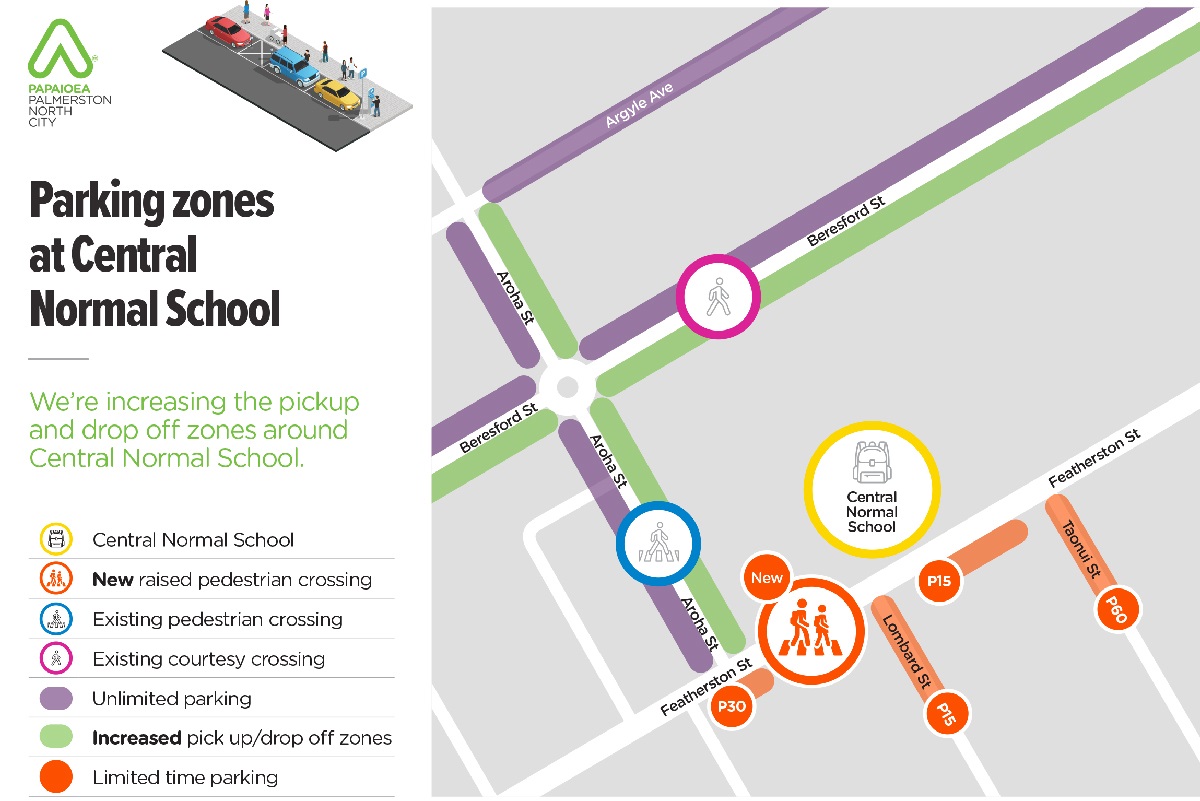We’re making some changes around Central Normal School in early-2024.
As you’ll be aware, there will be some changes to the area around Central Normal School as part of the Featherston Street cycleway and safety improvements from early 2024.
The main things changing around the school are:
- A new raised pedestrian crossing on Featherston Street
- New pick-up/drop-off zone on Lombard Street
- Extended pick-up/drop-off zones on Aroha and Beresford Streets
- P60 time restricted parking on Taonui Street
- Removal of pick up/drop off zone on Featherston Street
Construction between Central Normal and PNBHS is starting in early-2024
Our contractor has indicated they can start in early January with the section outside Central Normal School. Some of this construction may overlap at the start of the school year.
The sections outside of North to Aroha Streets have been delayed due to a funding pause by Waka Kotahi – NZ Transport Agency until the new Transport Minister takes office.
We co-designed the street alongside our community
This project has seen us carry out the most significant community engagement our Council has ever done for a transport project. At first, we sought feedback from the community before meeting with more than 130 businesses, schools and organisations to discuss their needs. We then invited representatives from each of these groups to come together over a series of workshops to co-design the cycleway and other safety improvements. The cycleway design proceeding to construction was supported by the majority of people at co-design. Our designers used all that feedback to design the new street.
Many residents, organisations and motorists have had to compromise on the design adjustments of the new street, and for Central Normal School it meant reconfiguring the pick-up/drop-off zone near the front entrance.

Parking on Featherston Street is being removed to accommodate space for uni-directional separated cycleway
We explained at co-design that if a uni-directional cycleway proceeded, only limited parking could be provided on one side of the street, and only in isolated areas. Seven parking spaces remain along the school front, but they are on the opposite side of the road for small businesses – as many of these do not have private off-street parking spaces, while businesses near the school on the same side all have large amounts of off-street parking.
Part of the cycleway design includes upgrading the school’s pedestrian crossing as there are plenty of side streets within the immediate vicinity of the school that can be better utilised to provide parking for picking up and dropping off pupils.
Limitations on parking in this area included raising the school’s pedestrian crossing, maintaining bus stops, and providing parking for small business across the road.
Currently, there are very few designated pick up/drop off zones around Central Normal School
Pick up and drop off zones are designated spaces for parents to park around 9am and 3pm. Residents, employees and customers can’t park in these areas at these times – allowing more space for you to drop off your children easily and safely. Currently, there are only a few spaces on Beresford and Aroha Streets where these rules apply, so we’re increasing the areas around Central Normal where these rules apply.
Increasing and relocating pick-up drop-off zones around Central Normal School
When elected members decided on the cycleway design in June, we explored how we could off-set the parking loss on Featherston St by better utilising other streets within the immediate vicinity of Central Normal. Central Normal has several of these, including Beresford, Aroha, Argyle, Taonui, Lombard and Campbell Streets.
Aroha/Beresford
Pick up and drop off zones will now be extended along the entire length of Arohoa and Beresford on the sides closest to the school, as these rules currently only apply to small sections of each. This will free up more space on these streets at pick up and drop off times.
Lombard/Taonui
We are installing P15 signs on sections of Lombard to enable pick up/drop offs. We’re also installing P60 signs on Taonui, which currently allows a mix of P120 and P240 restrictions – meaning they are currently used by employees of nearby businesses for extended periods.
Argyle
Our planning team have advised Argyle Street could be better utlised as a drop off/pick up zone as it provides a safe walking route within 200 metres of the school’s Beresford entrance (which is the same distance to park on Taonui and walk to the school entrance via the new raised pedestrian crossing).
Using Argyle is a good substitute for those of you who previously used the pick up/drop off zone on Featherston Street as it not only reduces the number of vehicles on Featherston Street and at the Rangitikei lights, but because you can still use the direct exit onto Rangitikei. Using this street will make your journey quicker by eliminating the time it takes to reenter the traffic lane on Featherston and waiting at the traffic lights during peak times.
We’ll monitor parking before and after construction
Part of our monitoring and evaluation after construction is to carry out more parking counts on these streets to determine if any of the parking zones need reviewing. You might also see us walking around to survey you to get your feedback.
Upgraded pedestrian crossing on Featherston to make it safer to cross from Taonui/Lombard/Campbell Streets
The new raised pedestrian crossing will provide a visible platform for your whānau to cross Featherston Street safely and get to or from school.
They raise pedestrians above the level of the road to make them more visible to drivers, reduce the total crossing distance and force vehicles to slow down. We plan to raise the pedestrian crossing on Aroha Street in time too.